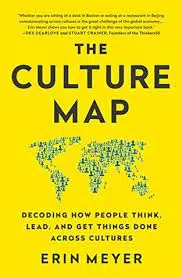The Culture Map: Breaking Through the Invisible Boundaries of Global Business is a book written by Erin Meyer, a professor at INSEAD and an expert on cross-cultural management. In the book, Meyer explores the ways in which cultural differences can impact communication and collaboration in the global business world. She identifies eight key dimensions of cultural difference, including communication, hierarchy, leadership, decision-making, trust, time, persuasion, and change, and offers practical advice for navigating these differences in order to build successful international teams and partnerships. Through a combination of research and real-life examples, Meyer provides insight into how cultural misunderstandings can lead to conflict and how to avoid them in order to foster effective communication and collaboration across cultural boundaries.
The main points of the book are:
- Culture plays a significant role in how people communicate and make decisions in organizations.
- Different cultures have different norms for communication, including verbal and nonverbal communication.
- There are eight dimensions of cultural difference that impact communication and decision-making: communication, hierarchy, trust, time, context, emotion, risk, and relationships.
- Communication styles can vary widely across cultures, with some cultures valuing direct communication and others valuing indirect communication.
- Hierarchies and power dynamics also vary across cultures, with some cultures valuing hierarchy and others valuing equality.
- Trust can also vary across cultures, with some cultures valuing personal relationships and others valuing institutional trust.
- Time is perceived and used differently in different cultures, with some cultures valuing punctuality and others valuing flexibility.
- Context, or the way in which information is shared, is important in understanding cultural differences.
- Emotional expression and management vary across cultures, with some cultures valuing emotional restraint and others valuing emotional expression.
- Risk taking and risk aversion vary across cultures, with some cultures valuing risk taking and others valuing caution.
- Relationships and social connections are important in many cultures, and the way in which they are formed and maintained can vary widely.
- Understanding cultural differences is crucial for effective communication and collaboration in a globalized world.
- It is important to recognize that culture is not fixed and can change over time.
- It is important to avoid stereotypes and to be aware of one’s own cultural biases.
- It is important to be open to learning about other cultures and to adapt one’s communication style as needed.
- It is important to be aware of the potential for misunderstandings and to be proactive in addressing them.
- It is important to be aware of the potential for conflict and to have strategies in place for managing it.
- It is important to be aware of the potential for culture shock and to have strategies in place for managing it.
- It is important to be aware of the potential for culture fatigue and to have strategies in place for managing it.
- It is important to be aware of the potential for culture overload and to have strategies in place for managing it.
- It is important to be aware of the potential for culture shock in virtual teams and to have strategies in place for managing it.
- It is important to be aware of the potential for culture fatigue in virtual teams and to have strategies in place for managing it.
- It is important to be aware of the potential for culture overload in virtual teams and to have strategies in place for managing it.
- It is important to have a clear and consistent communication strategy in virtual teams.
- It is important to have a clear and consistent decision-making process in virtual teams.
- It is important to have a clear and consistent approach to managing conflict in virtual teams.
- It is important to have a clear and consistent approach to managing diversity in virtual teams.
- It is important to have a clear and consistent approach to building trust in virtual teams.
- It is important to have a clear and consistent approach to managing cultural differences in virtual teams.
- It is important to have a clear and consistent approach to managing cultural change in virtual teams.
To buy the book click here


